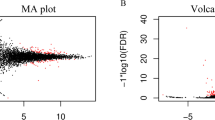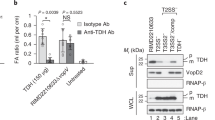Abstract
Analysis of the genome sequence of Vibrio parahaemolyticus reveals two IcmF family genes in putative type VI secretion system (vpT6SS) clusters in chromosomes 1 (icmF1) and 2 (icmF2). The icmF1 gene is present in majority of clinical isolates (87.5 %), but has a low fraction (25.0 %) in environmental isolates. However, icmF2 is contained in all strains of both clinical and environmental sources. Deletion of either icmF1 or hcp1 significantly reduced bacterial adhesion to Caco-2 cells or HeLa monolayers. However, the ΔicmF2 and Δhcp2 mutants showed decreased adhesion only to HeLa monolayers. Western blot analysis showed that Hcp2 was present both in the supernatant and pellet samples in the wild-type strain, but only in the pellet of the ΔicmF2 mutant, indicating that Hcp2 is a translocon of T6SS2. Although vpT6SS1 might be functional in cellular adhesion, the putative translocon Hcp1 was not detectable. Quantitative PCR revealed 10-fold and 17-fold less transcripts of hcp1 and icmF1 mRNA than those of hcp2 and icmF2 accordingly. Thus, we postulate that the putative vpT6SS systems contribute to adhesion of V. parahaemolyticus to host cells.




Similar content being viewed by others
Reference
Alam MJ, Tomochika KI, Miyoshi SI, Shinoda S (2002) Environmental investigation of potentially pathogenic Vibrio parahaemolyticus in the Seto-Inland Sea, Japan. FEMS Microbiol Lett 208:83–87
Bernard CS, Brunet YR, Gueguen E, Cascales E (2010) Nooks and crannies in type VI secretion regulation. J Bacteriol 192:3850–3860
Bingle LE, Bailey CM, Pallen MJ (2008) Type VI secretion: a beginner’s guide. Curr Opin Microbiol 11:3–8
Boyer F, Fichant G, Berthod J, Vandenbrouck Y, Attree I (2009) Dissecting the bacterial type VI secretion system by a genome wide in silico analysis: what can be learned from available microbial genomic resources? BMC Genomics 10:104
Burdette DL, Yarbrough ML, Orvedahl A, Gilpin CJ, Orth K (2008) Vibrio parahaemolyticus orchestrates a multifaceted host cell infection by induction of autophagy, cell rounding, and then cell lysis. Proc Natl Acad Sci USA 105:12497–12502
Cascales E (2008) The type VI secretion tool kit. EMBO Rep 9:735–741
Chao G, Jiao X, Zhou X, Wang F, Yang Z, Huang J, Pan Z, Zhou L, Qian X (2010) Distribution of genes encoding four pathogenicity islands (VPaIs), T6SS, biofilm, and type I pilus in food and clinical strains of Vibrio parahaemolyticus in China. Foodborne Pathog Dis 7:649–658
Chow J, Mazmanian SK (2010) A pathobiont of the microbiota balances host colonization and intestinal inflammation. Cell Host Microbe 7:265–276
Honda T, Ni Y, Miwatani T (1988) Purification and characterization of a hemolysin produced by a clinical isolate of Kanagawa phenomenon-negative Vibrio parahaemolyticus and related to the thermostable direct hemolysin. Infect Immun 56:961–965
Izutsu K, Kurokawa K, Tashiro K, Kuhara S, Hayashi T, Honda T, Iida T (2008) Comparative genomic analysis using microarray demonstrates a strong correlation between the presence of the 80-kilobase pathogenicity island and pathogenicity in Kanagawa phenomenon-positive Vibrio parahaemolyticus strains. Infect Immun 76:1016–1023
Jani AJ, Cotter PA (2010) Type VI secretion: not just for pathogenesis anymore. Cell Host Microbe 8:2–6
Kaper JB, Campen RK, Seidler RJ, Baldini MM, Falkow S (1984) Cloning of the thermostable direct or Kanagawa phenomenon associated hemolysin of Vibrio parahaemolyticus. Infect Immun 45:290–292
Krachler AM, Orth K (2011) Functional characterization of the interaction between bacterial adhesin multivalent adhesion molecule 7 (MAM7) protein and its host cell ligands. J Biol Chem 286:38939–38947
Lozano-León A, Torres J, Osorio CR, Martínez-Urtaza J (2003) Identification of tdh positive Vibrio parahaemolyticus from an outbreak associated with raw oyster consumption in Spain. FEMS Microbiol Lett 226:281–284
Mougous JD, Cuff ME, Raunser S, Shen A, Zhou M, Gifford CA, Goodman AL, Joachimiak G, Ordoñez CL, Lory S, Walz T, Joachimiak A, Mekalanos JJ (2006) A virulence locus of Pseudomonas aeruginosa encodes a protein secretion apparatus. Science 312:1526–1530
Nishibuchi M, Kaper BJ (1995) Thermostable direct hemolysin gene of Vibrio parahaemolyticus: a virulence gene acquired by a marine bacterium. Infect Immun 63:2093–2099
Nishibuchi M, Hill WE, Zon G, Payne WL, Kaper JB (1986) Synthetic oligodeoxyribonucleotide probes to detect Kanagawa phenomenon-positive Vibrio parahaemolyticus. J Clin Microbiol 23:1091–1095
Okada N, Iida T, Park KS, Goto N, Yasunaga T, Hiyoshi H, Matsuda S, Kodama T, Honda T (2009) Identification and characterization of a novel type III secretion system in trh-positive Vibrio parahaemolyticus strain TH3996 reveal genetic lineage and diversity of pathogenic machinery beyond the species level. Infect Immun 77:904–913
Park KS, Ono T, Rokuda M, Jang MH, Okada K, Iida T, Honda T (2004) Functional characterization of two type III secretion systems of Vibrio parahaemolyticus. Infect Immun 72:6659–6665
Parsons DA, Heffron F (2005) sciS, an icmF homolog in Salmonella enterica serovar Typhimurium, limits intracellular replication and decreases virulence. Infect Immun 73:4338–4345
Pukatzki S, Ma AT, Sturtevant D, Krastins B, Sarracino D, Nelson WC, Heidelberg JF, Mekalanos JJ (2006) Identification of a conserved bacterial protein secretion system in Vibrio cholerae using the Dictyostelium host model system. Proc Natl Acad Sci USA 103:1528–1533
Purcell M, Shuman HA (1998) The Legionella pneumophila icmGCDJBF genes are required for killing of human macrophages. Infect Immun 66:2245–2255
Raimondi F, Kao JPY, Fiorentini C, Fabbri A, Donelli G, Gasparini N, Rubino A, Fasano A (2000) Enterotoxicity and cytotoxicity of Vibrio parahaemolyticus thermostable direct hemolysin in in vitro systems. Infect Immun 68:3180–3185
Robert-Pillot A, Guenole A, Lesne J, Delesmont R, Fournier JM, Quilici ML (2004) Occurrence of the tdh and trh genes in Vibrio parahaemolyticus isolates from waters and raw shellfish collected in two France coastal areas and from seafood imported into France. Int J Food Microbiol 91:319–325
Sakarya S, Göktürk C, Öztürk T, Ertugrul MB (2010) Sialic acid is required for nonspecific adherence of Salmonella enterica ssp. enteriaca serovar Typhi on Caco-2 cell. FEMS Immunol Med Microbiol 58:330–335
Segal G, Purcell M, Shuman HA (1998) Host cell killing and bacterial conjugation require overlapping sets of genes within a 22-kb region of the Legionella pneumophila genome. Proc Natl Acad Sci USA 95:1669–1674
Sexton JA, Vogel JP (2002) Type IVB secretion by intracellular pathogens. Traffic 3:178–185
Shirai H, Ito H, Hirayama T, Nakamoto Y, Nakabayashi N, Kumagai K, Takeda Y, Nishibuchi M (1990) Molecular epidemiologic evidence for association of thermostable direct hemolysin (TDH) and TDH-related hemolysin of Vibrio parahaemolyticus with gastroenteritis. Infect Immun 58:3568–3573
Shrivastava S, Mande SS (2008) Identification and functional characterization of gene components of Type VI secretion system in bacterial genomes. PLoS ONE 3:e2955
Suarez G, Sierra JC, Sha J, Wang S, Erova TE, Fadl AA, Foltz SM, Horneman AJ, Chopra AK (2008) Molecular characterization of a functional type VI secretion system from a clinical isolate of Aeromonas hydrophila. Microb Pathog 44:344–361
Vongxay K, He X, Cheng S, Zhou X, Shen B, Zhang G, Zhang Y, Fang W (2006) Prevalence of Vibrio parahaemolyticus in seafood and their processing environments as detected by duplex PCR. J Sci Food Agric 86:1871–1877
Vongxay K, Wang S, Zhang X, Wu B, Hu H, Pan Z, Chen S, Fang W (2008) Pathogenic characterization of Vibrio parahaemolyticus isolates from clinical and seafood sources. Int J Food Microbiol 126:71–75
Wang Q, Liu Q, Ma Y, Rui H, Zhang Y (2007) LuxO controls extracellular protease, haemolytic activities and siderophore production in fish pathogen Vibrio alginolyticus. J Appl Microbiol 103:1525–1534
Weber B, Hasic M, Chen C, Wai SN, Milton DL (2009) Type VI secretion modulates quorum sensing and stress response in Vibrio anguillarum. Environ Microbiol 11:3018–3028
Yeung PS, Boor KJ (2004) Epidemiology, pathogenesis, and prevention of foodborne Vibrio parahaemolyticus infections. Foodborne Pathog Dis 1:74–89
Zheng J, Leung KY (2007) Dissection of a type VI secretion system in Edwardsiella tarda. Mol Microbiol 66:1192–1206
Zheng J, Shin OS, Cameron DE, Mekalanos JJ (2010) Quorum sensing and a lobal regulator TsrA control expression of type VI secretion and virulence in Vibrio cholerae. Proc Natl Acad Sci USA 107:21128–21133
Zhou X, Shah DH, Konkel ME, Call DR (2008) Type III secretion system 1 genes in Vibrio parahaemolyticus are positively regulated by ExsA and negatively regulated by ExsD. Mol Microbiol 69:747–764
Acknowledgments
This research is funded in part by Natural Science Foundation of China (30571436 to WHF and 30700605 to BBW) and the Key Project of National Science and Technology Pillar Program (2009BADB9B01). We thank Dr T. Iida at Osaka University for providing the suicide vector pYAK1.
Author information
Authors and Affiliations
Corresponding author
Additional information
Communicated by Jorge Membrillo-Hernandez.
Electronic supplementary material
Below is the link to the electronic supplementary material.
Rights and permissions
About this article
Cite this article
Yu, Y., Yang, H., Li, J. et al. Putative type VI secretion systems of Vibrio parahaemolyticus contribute to adhesion to cultured cell monolayers. Arch Microbiol 194, 827–835 (2012). https://doi.org/10.1007/s00203-012-0816-z
Received:
Revised:
Accepted:
Published:
Issue Date:
DOI: https://doi.org/10.1007/s00203-012-0816-z




